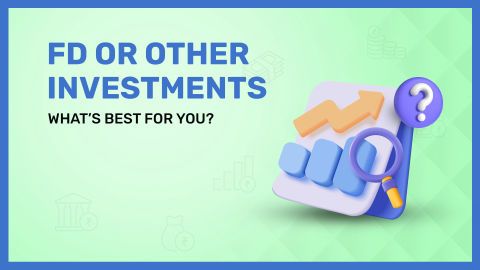As a potential investor, you might feel overwhelmed by the number of financial instruments available in the market today. An easy way to find your feet is to assess your financial goals, risk appetite and investment time horizon. You might find that you have multiple financial goals. Some goals, like purchasing a car or travelling abroad, are things you would like to do in a few months. Other goals might be years or decades away, like purchasing a home or building a retirement corpus.
Therefore, you will use safer, short-term investments to meet important near-term goals and use long-term, growth-oriented investments to meet long-term goals.
Read on to learn more about long-term investment vs short-term investment:
Difference between long-term and short-term investments
Different types of financial instruments serve different goals and come with distinct risk profiles and return expectations. Short-term investments are typically held for less than three years and are chosen for their liquidity and lower risk compared to long-term investments. Short-term investment vehicles include savings accounts, short-term fixed deposits, and liquid mutual funds. These investments generally help safeguard wealth and ensure moderate growth for investors.
On the other hand, long-term investments are generally held for several years or decades, offering the potential for higher returns at the cost of higher risk and lower liquidity. Equity shares, real estate, and long-term bonds are popular long-term investment options. This is typically the preferred route for investors aiming for significant wealth accumulation for future goals like retirement or children's education.
Here is a simple table to help you differentiate between long-term investments and short-term investments:
Aspect |
Short-Term Investing |
Long-Term Investing |
Duration |
Less than 3 years |
More than 5 years |
Risk Level |
Low |
High |
Typical Investments |
Savings accounts, short-term FDs |
Equity shares, real estate |
Return Expectations |
Low to Moderate |
Higher growth expectations |
Liquidity |
High |
Low to Moderate |
Short-term investment instruments
The key characteristics investors look for in short-term investments are liquidity, safety, and accessibility. Here are popular short-term investment instruments:
- Fixed Deposits: These are deposits with banks or financial institutions that offer guaranteed returns over a predetermined period. You can use a fixed deposit calculator to compute fixed-deposit interest rates and maturity.
- Liquid Funds: These funds invest in short-term market instruments and are known for their high liquidity.
- Treasury Bills: Issued by the government, these are secure instruments with maturities ranging from a few days to a year.
Long-term investing instruments
These instruments are typically more volatile in the short term but generate higher average returns in the long run:
- Equity Shares: Investing in the stock market can yield high returns over the long term as you gain from both capital appreciation and dividends.
- Mutual Funds: Diversified long-term mutual funds, especially equity or balanced funds, offer the potential for substantial growth over time.
- Real Estate: Property investment is a popular long-term option, providing benefits from rental income and capital appreciation.
Tactics of long-term investors
Long-term investors often adopt a 'buy and hold' strategy, investing in assets they believe will appreciate over time. As author Morgan Housel puts it, “Remember that investing is a long-term game, and long term means years and decades, not months and quarters”. Diversification is a key tactic, spreading investments across various asset classes to mitigate risk. Regularly reviewing and rebalancing the portfolio to align with one's financial goals and risk tolerance is also crucial for long-term investment success.
Tactics of short-term investors
It is important to not confuse short-term trading with short-term investments. Traders are a specific group of professionals who use various tools and technical data to try and beat the market in the short run. On the other hand, regular investors look for instruments that safeguard their wealth, forgoing higher returns for lower risk. Short-term investors often focus on investments with known maturity dates or those that can be easily liquidated. Risk management is vital, as is the need to avoid investments that might tie up funds longer than the investor's intended timeframe.
If you are looking for safe investment option, then you can consider investing Bajaj Finance Fixed Deposit. With a top-tier AAA rating from financial agencies like CRISIL and ICRA, they offer one of the highest returns, up to 7.30% p.a.
Planning long-term and short-term investment strategies
When it comes to investing, your time horizon plays a crucial role in shaping your approach. Both long-term and short-term investment strategies help you work toward financial goals, but they differ in purpose, risk, and structure.
Long-Term Investment Strategies
Long-term strategies are best suited for goals that are several years or even decades away—like retirement, buying a home, or funding your child’s education. Since these goals often require significant capital, planning early helps maximize returns through the power of compounding.
Short-Term Investment Strategies
Short-term strategies, on the other hand, are designed for goals that you aim to achieve within a few months to a few years—like taking a vacation, buying a car, or creating an emergency fund. These typically prioritize capital preservation and liquidity over high returns.
Key Questions to Consider Before Investing
Before you finalize your investment strategy—long or short term—ask yourself:
How much money will you need? Estimate your goal amount by considering factors like lifestyle, duration, and inflation.
What about taxes? Tax-efficient instruments such as ELSS, NPS, or 529 college savings plans can help you retain more of your returns.
When will withdrawals begin? Your timeline will determine how aggressive or conservative your investments should be.
How long will withdrawals last? For long-term goals like retirement, you may want systematic withdrawals; for short-term goals, a lump-sum withdrawal may suffice.
Will you invest once or regularly? Decide whether to make a one-time lump sum investment or contribute periodically to smooth out market volatility.
Which investment types suit you best? Choose based on your risk tolerance and expected returns—equities for long-term growth, debt or fixed deposits for stability.
Who should consider long-term investment strategies?
Long-term investments are ideal for individuals whose goals are seven years or more away. These strategies work well for those who want to:
Save for Retirement: Build a steady corpus for post-retirement income.
Save for Higher Education: Offset the rising costs of education over time.
Build Wealth: Benefit from compounding and market appreciation.
While equities and mutual funds can deliver higher returns over the long run, they also carry market risk. Hence, diversifying across asset classes—like bonds, FDs, and index funds—can balance risk and reward effectively.
In essence, both long-term and short-term investment strategies are essential. The key lies in aligning them with your financial goals, time horizon, and comfort with risk.
Find the right balance
Finding the right balance in short-term investment vs long-term investment consideration depends on your financial goals, age, risk tolerance, and investment horizon. Diversifying your investment portfolio across both short-term and long-term assets can help manage risk and provide financial stability. Regularly assessing your financial goals and adjusting your investment mix accordingly can help you stay on track to achieve your financial objectives.
Conclusion
As an investor, both short-term and long-term instruments will likely be part of your portfolio. Remember to churn your portfolio on a regular basis to get the most out of your investments. If in doubt, do not hesitate to seek the help of a trusted financial advisor. A small advisory fee could save your financial health from unforeseen pitfalls. Continue to learn more about these instrument types to make informed financial decisions.
Calculate your expected investment returns with the help of our investment calculators
Investment Calculator |
||||
Calculate your expected investment returns with the help of our investment calculators
Investment Calculator |
||
|
||




